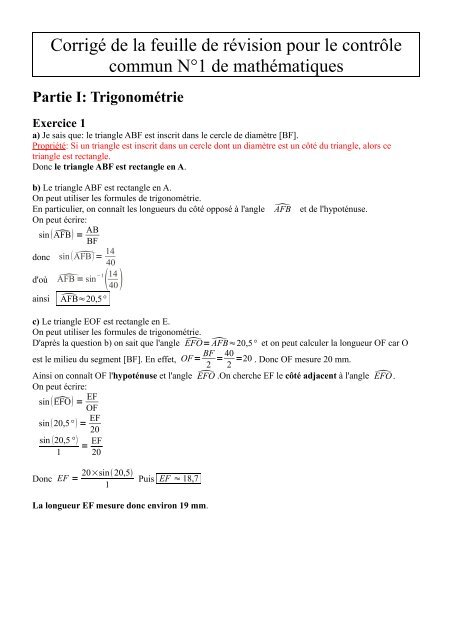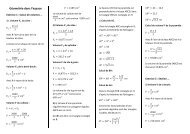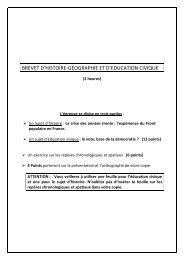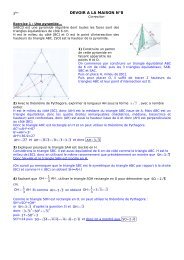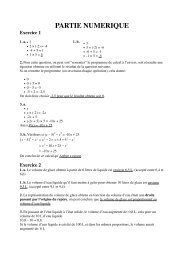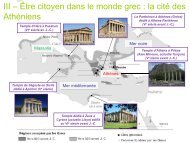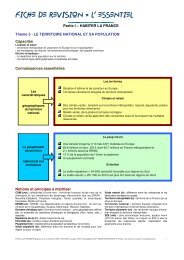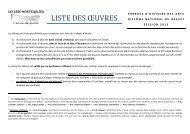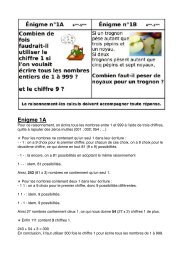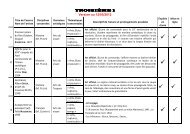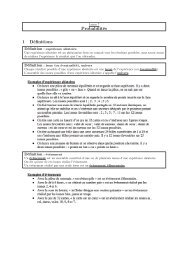Corrigé de la feuille de révision pour le contrôle commun N°1 de ...
Corrigé de la feuille de révision pour le contrôle commun N°1 de ...
Corrigé de la feuille de révision pour le contrôle commun N°1 de ...
- No tags were found...
Create successful ePaper yourself
Turn your PDF publications into a flip-book with our unique Google optimized e-Paper software.
!"#$% & #'#( #) #* &+ ,- -. #) //-1 /0 20&3( *) *#) #'- 45 - 20&3 )) !"#* & 2 /0 2 20 #') 20#+)- - #) * !,- #) *) *) 20&3 *20 20&3 *20' 2020&3$ 6&7" #$#
%" & '()*) +( 2 , -./##0#1 --,(!2 8 93 8 : ;9 32 3 : 8 23 2 :0 9 2 8 29 2 20 3 8 3 2 :/ 99 8 27 2 3 3/ :0 0 2 ; 3 : 8 2 :2 : 8 27 2 3 3/ :00 2 ; 3 : 8 7 2 ;6:: 8 / 2 9 8 ;0 28 6 2 8 00 2 20 :;8 ;/ 2 7; 2 8 2 :25 8 / 2 : : 8 7 2 6 6 0 8 70 2 606 8 6=5+ 0=>5 ? ###53 5( 4 2& 2#45( 4 & : 2 23 8 : 2 2 8 2 ; 9 2 8 ; 94( ? :9#) 4 ; 9 :9 #; 9 8 :9; 99 8 :99; 8 :0; :08;; 8 3) 4 34 :9 #
823 9 / 3 6 823 9 / 6 3 8 2 3 9/2/3 823 923 823 6 3 8263 8 ; 3 8 : / 6 : 9 2 6 : 8 ::/: 6/ :/ 96 2: 8 92 :2 8 22 2 8 22 2 8 2//2 ::/2 2:
Partie IV : Théorème <strong>de</strong> Pythagore etréciproqueExercice 1Le triang<strong>le</strong> MER est rectang<strong>le</strong> en E.D’après <strong>le</strong> théorème <strong>de</strong> Pythagore,Le segment [MR] mesure environ 8 cm.MR 2 = ME 2 + ER 2MR 2 = 4 2 +7 2MR 2 = 16+49MR 2 = 65MR = √ 65MR ≈ 8Exercice 2Le triang<strong>le</strong> ABC est rectang<strong>le</strong> en B.D’après <strong>le</strong> théorème <strong>de</strong> Pythagore,AC 2 = AB 2 + BC 26,8 2 = 5,2 2 + BC 2BC 2 = 6,8 2 − 5,2 2BC 2 = 46,24 − 27,04BC 2 = 19,2BC = 19,2BC ≈ 4,4Le segment [BC] mesure environ 4,4 cm.Exercice 31) Le plus grand côté du triang<strong>le</strong> XYZ est [XY].D’une part,D’autre part,XY 2 = 29,8 2XZ 2 + YZ 2 = 10,2 2 +28,1 2XY 2 = 888,04XZ 2 + YZ 2 = 893,65Ainsi, XY 2 = XZ 2 +YZ 2 et d’après <strong>le</strong> théorème <strong>de</strong> Pythagore (contraposée), <strong>le</strong> triang<strong>le</strong>XYZ n’est pas rectang<strong>le</strong>.2) Le plus grand côté du triang<strong>le</strong> ALE est [AL].D’une part,D’autre part,AL 2 = 13 2AE 2 + LE 2 = 6,6 2 +11,2 2AL 2 = 169AE 2 + LE 2 = 43,56 + 125,44AE 2 + LE 2 = 169Ainsi, AL 2 = AE 2 +LE 2 et d’après <strong>la</strong> réciproque du théorème <strong>de</strong> Pythagore, <strong>le</strong> triang<strong>le</strong>ALE est rectang<strong>le</strong> en E.
Partie V : Volumes1) Volume du cylindreLa formu<strong>le</strong> <strong>pour</strong> calcu<strong>le</strong>r <strong>le</strong> volume d’un cylindre <strong>de</strong> rayon R et <strong>de</strong> hauteur h est : πR 2 h.Ici, R =3cm et h =4cm.Ainsi <strong>le</strong> volume V du cylindre vaut : V = π × 3 2 × 4,c’est-à-dire V =36π,soit V ≈ 113.Le volume <strong>de</strong> ce cylindre vaut donc 36π cm 3 ,soitenviron113cm 3 .2) Volume du cylindreLa formu<strong>le</strong> <strong>pour</strong> calcu<strong>le</strong>r <strong>le</strong> volume d’un cylindre <strong>de</strong> rayon R et <strong>de</strong> hauteur h est : πR 2 h.Ici, R =5dm (attention aux unités) eth =6dm.Ainsi <strong>le</strong> volume V du cylindre vaut : V = π × 5 2 × 6,c’est-à-dire V =150π,soit V ≈ 471.Le volume <strong>de</strong> ce cylindre vaut donc 150π dm 3 ,soitenviron471dm 3 .3) Volume d’un prisme droitLa formu<strong>le</strong> <strong>pour</strong> calcu<strong>le</strong>r <strong>le</strong> volume d’un prisme droit <strong>de</strong> hauteur h est :(Aire <strong>de</strong> <strong>la</strong> base) × h.Ici, <strong>la</strong> base est un triang<strong>le</strong> et <strong>la</strong> hauteur vaut 5 cm.Pour calcu<strong>le</strong>r l’aire <strong>de</strong> <strong>la</strong> base, on calcu<strong>le</strong> l’aire du triang<strong>le</strong> avec <strong>la</strong> formu<strong>le</strong> :ce qui donne : 4 × 3 =6.2Ainsi <strong>le</strong> volume V du prisme vaut : V =6× 5,c’est-à-dire V =30.Le volume <strong>de</strong> ce prisme vaut donc 30 cm 3 .4) Volume d’une pyrami<strong>de</strong>La formu<strong>le</strong> <strong>pour</strong> calcu<strong>le</strong>r <strong>le</strong> volume d’une pyrami<strong>de</strong> <strong>de</strong> hauteur h est :base × hauteur,2(Aire <strong>de</strong> <strong>la</strong> base) × h.3Ici, <strong>la</strong> base est un carré <strong>de</strong> côté 2,4 cm et <strong>la</strong> hauteur vaut 5 cm.Pour calcu<strong>le</strong>r l’aire <strong>de</strong> <strong>la</strong> base, on calcu<strong>le</strong> l’aire du carré avec <strong>la</strong> formu<strong>le</strong> : A = c 2 ,cequidonne : A =2,4 2 et donc A =5,76.Ainsi <strong>le</strong> volume V <strong>de</strong> <strong>la</strong> pyrami<strong>de</strong> vaut : V = 5,76 × 5 ,3c’est-à-dire V = 28,8 et donc V =9,6.3Le volume <strong>de</strong> cette pyrami<strong>de</strong> vaut donc 9,6 cm 3 .5) Volume d’un côneLa formu<strong>le</strong> <strong>pour</strong> calcu<strong>le</strong>r <strong>le</strong> volume d’un cône <strong>de</strong> rayon R et <strong>de</strong> hauteur h est : πR2 h.3Ici, <strong>le</strong> rayon vaut 1,5 cm (car AB = OS = 3 cm) et <strong>la</strong> hauteur vaut 3 cm.Ainsi <strong>le</strong> volume V du cône vaut : V = π × 1,52 × 3,3c’est-à-dire V =2,25π, soitV ≈ 7.Le volume <strong>de</strong> ce cône vaut donc 2,25π cm 3 ,soitenviron7cm 3 .


